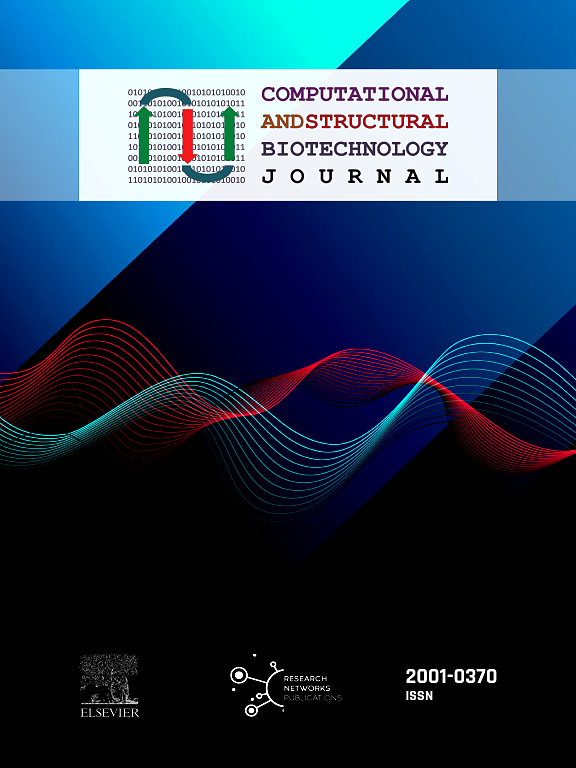Easy-MODA: Simplifying standardised registration of scientific simulation workflows through MODA template guidelines powered by the Enalos Cloud Platform
IF 4.4
2区 生物学
Q2 BIOCHEMISTRY & MOLECULAR BIOLOGY
Computational and structural biotechnology journal
Pub Date : 2024-10-18
DOI:10.1016/j.csbj.2024.10.018
引用次数: 0
Abstract
Modelling Data (MODA) reporting guidelines have been proposed for common terminology and for recording metadata for physics-based materials modelling and simulations in a CEN Workshop Agreement (CWA 17284:2018). Their purpose is similar to that of the Quantitative Structure-Activity Relationship (QSAR) model report form (QMRF) that aims to increase industry and regulatory confidence in QSAR models, but for a wider range of model types. Recently, the WorldFAIR project’s nanomaterials case study suggested that both QMRF and MODA templates are an important means to enhance compliance of nanoinformatics models, and their underpinning datasets, with the FAIR principles (Findable, Accessible, Interoperable, Reusable). Despite the advances in computational modelling of materials properties and phenomena, regulatory uptake of predictive models has been slow. This is, in part, due to concerns about lack of validation of complex models and lack of documentation of scientific simulations. The models are often complex, output can be hardware- and software-dependent, and there is a lack of shared standards. Despite advocating for standardised and transparent documentation of simulation protocols through its templates, the MODA guidelines are rarely used in practice by modellers because of a lack of tools for automating their creation, sharing, and storage. They also suffer from a paucity of user guidance on their use to document different types of models and systems. Such tools exist for the more well-established QMRF and have aided widespread implementation of QMRFs. To address this gap, a simplified procedure and online tool, Easy-MODA, has been developed to guide users through MODA creation for physics-based and data-based models, and their various combinations. Easy-MODA is available as a web-tool on the Enalos Cloud Platform (https://www.enaloscloud.novamechanics.com/insight/moda/). The tool streamlines the creation of detailed MODA documentation, even for complex multi-model workflows, and facilitates the registration of MODA workflows and documentation in a database, thereby increasing their Findability and thus Re-usability. This enhances communication, interoperability, and reproducibility in multiscale materials modelling and improves trust in the models through improved documentation. The use of the Easy-MODA tool is exemplified by a case study for nanotoxicity evaluation, involving interlinked models and data transformation, to demonstrate the effectiveness of the tool in integrating complex computational methodologies and its significant role in improving the FAIRness of scientific simulations.
Easy-MODA:通过Enalos云平台提供的MODA模板指南简化科学模拟工作流程的标准化注册
在 CEN 研讨会协议(CWA 17284:2018)中提出了建模数据(MODA)报告指南,用于基于物理的材料建模和模拟的通用术语和元数据记录。其目的与定量结构-活性关系(QSAR)模型报告表(QMRF)类似,旨在提高行业和监管机构对 QSAR 模型的信心,但适用于更广泛的模型类型。最近,WorldFAIR 项目的纳米材料案例研究表明,QMRF 和 MODA 模板都是提高纳米信息模型及其基础数据集符合 FAIR 原则(可查找、可访问、可互操作、可重复使用)的重要手段。尽管在材料特性和现象的计算建模方面取得了进展,但监管机构对预测模型的采用却一直很缓慢。部分原因是人们担心复杂的模型缺乏验证,科学模拟缺乏文件记录。模型通常很复杂,输出结果可能取决于硬件和软件,而且缺乏共享标准。尽管 MODA 准则提倡通过模板对模拟协议进行标准化和透明化记录,但由于缺乏自动创建、共享和存储工具,建模人员在实践中很少使用 MODA 准则。此外,关于如何使用它们来记录不同类型的模型和系统,也缺乏用户指南。这些工具适用于较为成熟的 QMRF,并有助于 QMRF 的广泛实施。为了弥补这一不足,我们开发了一种简化程序和在线工具--Easy-MODA,以指导用户创建基于物理和数据的模型及其各种组合的 MODA。Easy-MODA是Enalos云平台(https://www.enaloscloud.novamechanics.com/insight/moda/)上的一个网络工具。该工具简化了详细MODA文档的创建,即使是复杂的多模型工作流程也不例外,并有助于在数据库中注册MODA工作流程和文档,从而提高其可查找性和可重用性。这增强了多尺度材料建模的交流、互操作性和可重复性,并通过改进文档提高了对模型的信任度。Easy-MODA 工具的使用以纳米毒性评估的案例研究为例,其中涉及相互关联的模型和数据转换,以证明该工具在整合复杂计算方法方面的有效性及其在提高科学模拟的公平性方面的重要作用。
本文章由计算机程序翻译,如有差异,请以英文原文为准。
求助全文
约1分钟内获得全文
求助全文
来源期刊

Computational and structural biotechnology journal
Biochemistry, Genetics and Molecular Biology-Biophysics
CiteScore
9.30
自引率
3.30%
发文量
540
审稿时长
6 weeks
期刊介绍:
Computational and Structural Biotechnology Journal (CSBJ) is an online gold open access journal publishing research articles and reviews after full peer review. All articles are published, without barriers to access, immediately upon acceptance. The journal places a strong emphasis on functional and mechanistic understanding of how molecular components in a biological process work together through the application of computational methods. Structural data may provide such insights, but they are not a pre-requisite for publication in the journal. Specific areas of interest include, but are not limited to:
Structure and function of proteins, nucleic acids and other macromolecules
Structure and function of multi-component complexes
Protein folding, processing and degradation
Enzymology
Computational and structural studies of plant systems
Microbial Informatics
Genomics
Proteomics
Metabolomics
Algorithms and Hypothesis in Bioinformatics
Mathematical and Theoretical Biology
Computational Chemistry and Drug Discovery
Microscopy and Molecular Imaging
Nanotechnology
Systems and Synthetic Biology
 求助内容:
求助内容: 应助结果提醒方式:
应助结果提醒方式:


